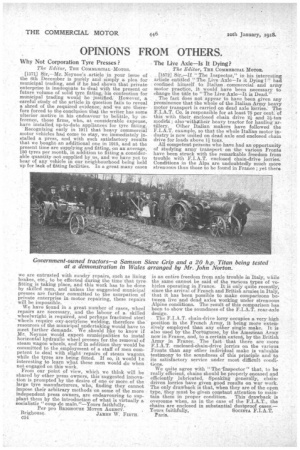OPINIONS FROM OTHERS.
Page 22

If you've noticed an error in this article please click here to report it so we can fix it.
Why Not Corporation Tyre Presses ?
The Editor, THE COMMERCIAL MOTOR.
[1571,1 6ir,-111r. Neynoe's -article in your issue of the 6th. December is purly and simply a plea for municipal trading, and if he had shown that private enterprise is inadequate to deal with the present or future volume of solid tyre fitting, his contention for municipal trading would be justified: However, a careful study of the article in question fails to reveal shred of the required evidence, and we are therefore forced to the conclusion tha the writer has some ulterior motive in his endeavour to belittle, by inference, those firms who, at considerable expense, have installed, up-to-date appliances for tyre fitting.
Recognizing early in 1911 that heavy coinmercial motor vehicles had come to stay, we immediately installed a press, and with such satisfactory results that we bought an additional one in 1915, and at the present time are supplying and fitting On an average, 150 tyres per month, in addition to fitting a considerable quantity not supplied by us, and we have yet to hear of any vehicle in our neighbourhood being held up for lack of fitting facilities. In a great many cases we are entrusted with sundry repairs, such as lining brakes, etc, to be effected during the time that tyre fitting is tailing place, and this work has to be done by skilled men, and unless the suggested municipal presses are further committed to the usurpation of private enterprise in motor repairing, these repairs will be impossible.
We have found in a great number of cases, wheel repairs are necessary, and the labour of a skilled wheelwright is required, and perhaps fractured steel wheels require oxyacetylene welding, therefore the resources of the municipal undertaking would have to meet further demands. We should like to know if 31r. Neynoe would expect municipalities to instal horizontal hydraulic wheel presses for the removal of steam wagon wheels, and if in addition they would be committed to the employment of a staff of men competent to deal with slight repairs of steam wagona while the tyres are being fitted. If so, it would I e interesting to learn what these men would do when not engaged on this work.
From our point of view, which we think will be shared by other press owners, this -suggested innovation is prompted by the desire of one or more of the large tyre manufacturers, who, finding they cannot impose their arbitrary methods on some of the more independent press owners, are endeavouring to supplant them by the introduction of what is virtually a socialistic "coup de main."—Yours faithfully,
Per pro BRIGHOUSE MOTOR AGENCY. Brighouse. JAMES W. FIRTH. c51
The Live Axle—Is It Dying?
The Editor, THE COMMERCIAL MOTOR.
. [1572] Sir,—If "The Inspector," in his interesting article entitled "The Live Axle—Is it Dying ?" had confined himself to Italian.. commercial and army motor practice, it would have been necessary to change the title to "The Live Axle—It is Dead."
The fact does not appear to have been given any prominence that the whole of the Italian Army heavy motor transport is carried on dead axle lorries. The F.I.A.T. Co. is responsible for at least 75 per cent: of this with their enclosed chain drive 24 and 3i-ton models ; ,also.withOtheir heavy tractor for hauling artillery. Other Italian makers have followed the F.I.A.T. example, so that the whole Italian motor industry is now united on dead aide and enclosed chain drive for loads above tons.
All competent persons who have had an opportunity of studying army transport on the various Fronts have been struck with the remarkable freedom from trouble with F.I.A.T. enclosed chain-drive lorries. Conditions in the Alps are undoubtedly much more strenuous than those to be found in France ; yet there is an entire freedom from axle trouble in Italy, while the same cannot be said of the various types of vehicles operating in France. It is only quite recently, since the arrival of French and British armies in Italy, that it has been possible to make comparisons between live and dead axles working under strenuous Alpine conditions. The result of this comparison has been to show the soundness of the F.I.A.T. rear-axle design. . The F.I.A.T. chain-drive lorry occupies a very high position in the French Army, it being more extensively employed than any other single make. It is also used by the Portuguese, by the American Array • now in France, and, to a certain extent, by the British Army in France. The fact that there are more F.I.A.T. enclosed-chain-drive lorries on the various Fronts than any other individual make is valuable testimony to the soundness of this principle and to its satisfactory service under most difficult conditions.
We quite agree with " The Inspector" that, to be really efficient, chains should be properly encased and efficiently lubricated. Speaking generally, chaindriven lorries -have given good results on war work. The only drawback is that, when they are of the open type, they must be given constant attention to maintain them in proper condition. This drawback is overcome when, as in the case of the F.I.A.T., the chains are enclosed in substantial dustproof cases.— Yours faithfully, SOCIETA F.I.A.T. Paris.
























